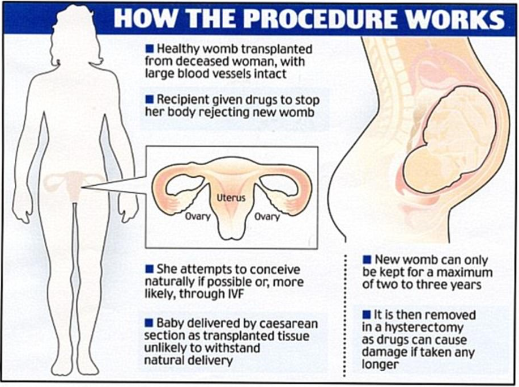- Courses
- GS Full Course 1 Year
- GS Full Course 2 Year
- GS Full Course 3 Year
- GS Full Course Till Selection
- Answer Alpha: Mains 2025 Mentorship
- MEP (Mains Enrichment Programme) Data, Facts
- Essay Target – 150+ Marks
- Online Program
- GS Recorded Course
- Polity
- Geography
- Economy
- Ancient, Medieval and Art & Culture AMAC
- Modern India, Post Independence & World History
- Environment
- Governance
- Science & Technology
- International Relations and Internal Security
- Disaster Management
- Ethics
- NCERT Current Affairs
- Indian Society and Social Issue
- NCERT- Science and Technology
- NCERT - Geography
- NCERT - Ancient History
- NCERT- World History
- NCERT Modern History
- CSAT
- 5 LAYERED ARJUNA Mentorship
- Public Administration Optional
- ABOUT US
- OUR TOPPERS
- TEST SERIES
- FREE STUDY MATERIAL
- VIDEOS
- CONTACT US
Uterus Transplantation
Uterus Transplantation
10-10-2023

Context
Recently, UK has successfully performed its first uterus transplant, offering new hope to women grappling with reproductive issues.
- Status in India: India celebrated its first uterine transplant baby in 2018, just 17 months after the procedure, joining Turkey, Sweden, and the United States in successful uterus transplants.
What is a Uterus Transplant?
- About: A uterine transplant is a surgical procedure whereby a healthy uterus is transplanted into an organism of which the uterus is absent or diseased.
-
- Uterus transplants, unlike heart or liver transplants, are not life-saving but rather improve the quality of individuals' lives, similar to limb or skin transplants.
-
-
Step-by-Step Procedure:
-
- Recipient Evaluation: Prior to transplantation, recipients undergo comprehensive assessments to evaluate their physical and mental well-being.
- Donor Assessment: The donor's uterus undergoes viability checks and comprehensive gynecological examinations, including imaging scans and cancer screenings, before qualifying for donation.
-

-
-
- Harvesting and Transplantation: Robot-assisted laparoscopy advancements make the donor's uterus removal procedure less invasive, while re-establishing critical connections and uterine vasculature during transplantation.
-

-
Post-Transplant Pregnancy:
-
- Success is determined through three stages:
-
- The study focuses on assessing the viability of grafts within the initial three months.
- The assessment of uterus function is typically conducted between six months and one year.
- In vitro fertilization is a method of attempting pregnancy, but it comes with higher risks such as rejection or complications.
- The final stage of success is a successful childbirth.
-
-
- Regular check-ups are crucial to prevent risks such as rejection, abortion, low birth weight, and premature birth.
-
-
Issues with such transplants
-
-
- Challenges and Risks: Uterine transplant pregnancy increases risk of rejection, spontaneous abortion, intrauterine complications, low birth weight, and premature birth, necessitating close monitoring and follow-ups.
- Immunosuppressant Use: Recipients of transplanted uterus require immune-suppressing drugs to prevent rejection, avoiding side effects like kidney toxicity, bone marrow issues, diabetes, and cancer.
- Long-Term Follow-Ups: Post-uterus removal, it is recommended that recipients undergo regular follow-ups for at least a decade to monitor the long-term effects of immunosuppressant drugs.
-
Way Forward
Researchers, at the University of Gothenburg, are working on bioengineered uteri. These are created using stem cells taken from a woman's blood or bone marrow as a foundation for a 3D scaffold.
-
- Preliminary experiments with rats shows promising result.
- Artificial uteri could eliminate the need for live donors, addressing ethical concerns and reducing potential risks to healthy individuals.
- Artificial uteri has the potential to benefit women experiencing infertility and members of the LGBTQ+ community.
Conclusion
Technologies like Artificial uteri offer exciting possibilities for reproductive medicine but require further research and development before becoming a practical solution for human reproduction.



